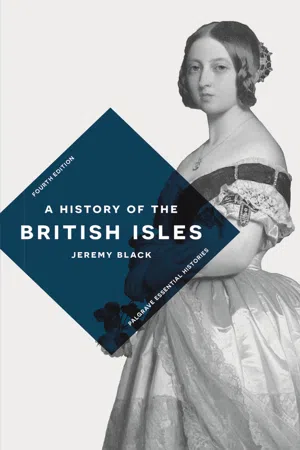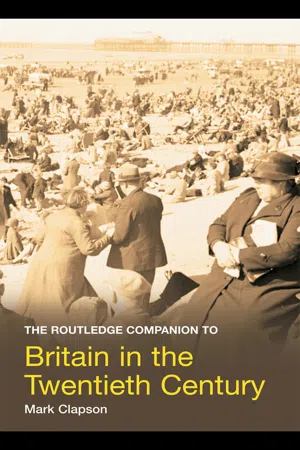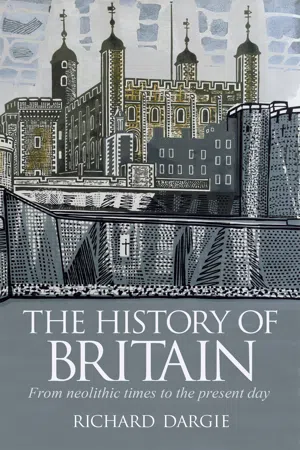Britain 20th Century
The 20th century in Britain was marked by significant social, political, and economic changes. It saw the decline of the British Empire, two world wars, the rise of the welfare state, and the transformation of British society through cultural shifts and technological advancements. The century also witnessed struggles for civil rights, gender equality, and the emergence of a multicultural society.
7 Key excerpts on "Britain 20th Century"
- eBook - ePub
- Jeremy Black(Author)
- 2017(Publication Date)
- Bloomsbury Academic(Publisher)
...8 The Twentieth Century TECHNOLOGY, CHANGE AND THE STATE OF THE NATION War and the loss of empire framed the political experience of Britain from the outbreak of the First World War (1914) to the 1960s, but the environmental, medical, social and economic contexts of British life, as well as the nature of personal experience, were all to be transformed totally as a result of technological innovation and application. The nineteenth century had brought major changes and an increasing sense of continual change. The twentieth century truly witnessed revolutionary transformations in theoretical and applied science and in technology in most fields, whether transport, the generation and distribution of power, medicine, contraception, agricultural yields, or the accumulation, storing and manipulation of information. As a result of these changes, the wealth was created, and means provided, to make feasible the suggestion that man’s lot on earth could be substantially improved. Change would be so all-encompassing that fears of permanent damage to the environment and to mankind itself would become a major issue from the 1960s, though worried voices had been raised earlier...
- Mark Clapson(Author)
- 2009(Publication Date)
- Routledge(Publisher)
...Many conservative historians thus see the 1980s as the decade that remade Britain: the restructuring of the economy and the wave of patriotism generated by the Falklands War of 1982 restored self-confidence in Britain following the problems of the previous decade. During the 1990s, the long period of Conservative government came to an end, and in 1997 a new political agenda was evident in the rise of New Labour. This last point is an important reminder that most historians never focus completely on one decade in isolation: they look for continuities between decades, and try to identify the consequences of a decade of change in its immediate or medium-term aftermath. The social and cultural innovations now associated with the 1960s, and the economic problems of the 1970s, for example, did not simply begin on the first day of each decade and end on 31 December 1969 or 1979. On modern and contemporary history The twentieth century witnessed the overlap between modern and contemporary history. By the modern period in Britain, historians often refer to the beginnings of mass urbanisation and industrialisation during the mid-eighteenth century, through to a cut-off date during the twentieth century. That cut-off date has been the First World War, the Second World War, and even later, including the present day. ‘Modern’ is a flexible adjective, and the time span associated with it is also moveable. Historians also debate the legitimate temporal beginning of the ‘contemporary’ period. According to John Barnes, this is usefully viewed as the period within living memory for the majority of people. Hence the interwar period by this temporal definition may be viewed within the broad era of ‘contemporary’ history today...
- eBook - ePub
- Stephen J. Lee(Author)
- 2005(Publication Date)
- Routledge(Publisher)
...20 THE BRITISH EMPIRE AND COMMONWEALTH IN THE TWENTIETH CENTURY The British Empire had developed as a result of very different cycles of growth. During the eighteenth century, the colonisation of India and North America had been based on commercial exploitation and military conquest, usually in wars against France. Then, for much of the nineteenth century there was a reluctance at Whitehall to increase the number of dependencies, largely on the grounds of expense. From about 1870 onwards, however, the Empire expanded rapidly in the hitherto largely untapped areas of Africa and the Pacific. By 1914 the Empire covered nearly one quarter of the earth's land surface, including self-governing Dominions such as Canada, Australia, New Zealand and South Africa; in Asia, the British Raj, Malaya, Singapore and Hong Kong; in the East Indies and Pacific, New Guinea, North Borneo, and Fiji; in central America, Guiana and Honduras and a series of West Indian islands including Jamaica, Trinidad and Barbados; in Africa, Basutoland, Swaziland, Bechuanaland, the Rhodesias, Nyasaland, Kenya, Uganda, the Sudan, Egypt, Nigeria, the Gold Coast, Sierra Leone and Gambia; and, in the Mediterranean, Gibraltar, Malta and Cyprus. The twentieth century, however, saw the gradual reduction of this array of colonies until, by 1995, the only formal dependencies left were Hong Kong (due to revert to China in 1997), Gibraltar and a handful of remote island colonies, the largest of which were the Falklands. This chapter considers the two main stages in the process of the weakening of the Empire: between the two world wars and the period since 1945. There are really two sides to the same coin: the decline of formal imperial rule and the emergence of the British Commonwealth. As one faded and expired, the other grew and matured. The first cannot, in retrospect, be considered surprising...
- eBook - ePub
- Carlos Sabillon(Author)
- 2019(Publication Date)
- Routledge(Publisher)
...8 Great Britain During the Second Half of the Twentieth Century Culture and Growth During the second half of the twentieth century, Britain attained one of the slowest rates of economic growth among OECD countries. Not only was it one of the slowest, but the gap with many of these countries was considerable. The large majority of its Western European neighbors and practically all of its former colonies in North America and Oceania grew at a considerably faster pace. Worse still was the fact that the rates were so relatively weak that the British population was forced to very high levels of underemployment and unpleasant levels of unemployment during the whole period. Real incomes grew at a very slow pace and income distribution tended to worsen notwithstanding the numerous social welfare programs. This was actually the second half-century period in which Britain attained slower GDP figures than the bulk of OECD countries. During the first half of the twentieth century, the large majority of the future OECD countries attained rates of economic growth that were faster than Britain’s. Even during the second half of the nineteenth century, numerous nations in Western Europe, North America, Oceania, and Japan grew faster than Britain. (See tables at the end of the book.) Such a persistent underperformance convinced numerous British policy makers and economists that there was something about the British culture that inhibited fast growth. It was asserted, in particular during the 1950s and 1960s when the growth gap with other developed countries was the widest, that the British were disinclined for work and that they were reluctant to invest...
- eBook - ePub
The History of Britain
From neolithic times to the present day
- Richard Dargie(Author)
- 2020(Publication Date)
- Arcturus(Publisher)
...The Twentieth Century and Beyond The Birth of the Welfare State 1902–1912 At the turn of the century, the governing Conservative administration was more interested in imperial than domestic matters. After 1906, however, a radical Liberal government began to seriously tackle the effects of decades of social and economic transformation. Imperial Jubilee The 1897 Diamond Jubilee celebrated the high noon of empire. Colonial troops from every continent parading through the streets of London featured on the pages of pictorial supplements in the daily press. The following year, at Omdurman in the Sudan, Lord Kitchener’s maxim guns decimated the forces of the Mahdi, a self-proclaimed Muslim ‘prophet’, and avenged the death of General Gordon at Khartoum. However, the celebrations and victories were quickly forgotten as imperial adventure almost resulted in war with France over the Upper Sudan in 1898 and then degenerated into an expensive and initially humiliating conflict in South Africa. The Conservative government did enact two significant pieces of reform legislation; the Workmen’s Compensation Act that helped those injured at work, and Balfour’s 1902 Education Act, which laid the foundation for a national system of secondary schools. This Act was designed to improve ‘national efficiency’ at a time when Britain’s economic supremacy had been surrendered to the USA and Germany. It passed responsibility for enforcing standards in all publicly financed schools to county and borough councils. Landslide Divided over the issue of empire trade and tarred with the Boer War brush, the Conservatives were badly defeated in the 1906 election. The new Commons consisted of 377 Liberals, 53 Labour and other socialists and 83 Irish Nationalists. Many in the new Liberal government, such as Lloyd George, Winston Churchill and John Burns, were of a radical stamp, much influenced by the studies of working class poverty made by Charles Booth and Benjamin Seebohm Rowntree...
- eBook - ePub
A History of England, Volume 2
1688 to the present
- Clayton Roberts, David F. Roberts, Douglas Bisson(Authors)
- 2016(Publication Date)
- Routledge(Publisher)
...C HAPTER 28 B RITAIN B ETWEEN THE W ARS Chapter Outline ■ The Economy ■ Unemployment, Poverty, and Inequality ■ The Rise of Labour and the Decline of the Liberals ■ The Ascendant Tories ■ Progress and Disillusionment L IFE IN BRITAIN IN THE 1920s AND 1930s was varied and changeable. There was something for everyone in its kaleidoscopic patterns: drowsy vicarages and rose gardens for leftover Victorians; nightclubs and the Charleston for the moderns; destitution, unhappily for the jobless; riches, happily, for land promoters; tumultuous strikes for shop stewards; deferential waiters for rich diners; and politics of every variety—Tory, Liberal, Labour, Communist, Fascist, and Vegetarian. The tempo of life was often hectic and the tone strident, as insecurity and class hatreds mingled with brashness and cupidity. The 1920s were haunted by nightmares of the last war; the 1930s were haunted by fears of the next. But even more profound than these fears and nightmares in defining the reigning mood of the interwar years was the erratic behavior of the British economy. T HE E CONOMY From 1918 to 1939 blooms, slumps, strikes, recoveries, crashes, depressions, and revivals followed one another with a suddenness and unpredictability that puzzled the economist and frustrated the statesman. No single phrase can describe its ebb and flow, its eddies and currents, unless it is the phrase "age of unevenness." It was uneven in the ups and downs of the business cycle; it was uneven in its geographical variations. The years 1919-20, 1924-29, 1934-37, and 1939 witnessed growth; 1920-24, 1930-34, and 1937-38 saw slumps, crises, and depression. Expanding industries graced the south and Midlands of England, while declining industries plagued Scotland, Wales, and the north...
- eBook - ePub
Welfare Beyond the Welfare State
The Employment Relationship in Britain and Germany
- Felix Behling(Author)
- 2018(Publication Date)
- Palgrave Macmillan(Publisher)
...© The Author(s) 2018 Felix Behling Welfare Beyond the Welfare State https://doi.org/10.1007/978-3-319-65223-8_3 Begin Abstract 3. Building the Welfare State in the Nineteenth Century Felix Behling 1 (1) Sociological Research Institute (SOFI), Göttingen, Germany End Abstract Introduction The nineteenth century saw the rapid unfolding of economic, political and social changes in Germany and the UK. At the turn of the century, Germany as a state did not yet exist and instead comprised several states of which the majority were small and regional. The UK, on the other hand, had been a state since the unification of England, Scotland and Wales in 1707. The UK had also engaged in overseas economic and political campaigns during the seventeenth and eighteenth centuries, which had expanded its sphere of influence to a global level, whereas the German states mostly pursued campaigns geographically limited to the European continent, not seeking to enter global politics until the second half of the nineteenth century. Most importantly, the existing global dimension of British politics and economics had led to industrial forms of production during the eighteenth century, with the result that Germany and the UK entered the nineteenth century from two very different positions (Hartwell 1967). Britain came to be known as the “workshop of the world” (for example described by Disraeli, see Hansard 1838). However, with the end of the long nineteenth century and the onset of the First World War (Hobsbawm 1987), these differences had almost disappeared, except for the sheer scale of the British Empire, on which the sun, famously, never set. Germany had a higher GDP (Gross Domestic Product) per capita than the UK and Alfred Chandler suggested that it came second only to the US, which equally underwent a rapid expansion and overtook the UK economically (Chandler 1994)...






